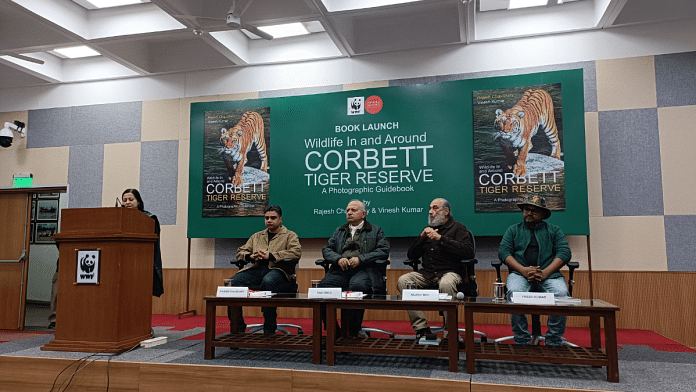New Delhi: Every weekend for five years, Delhi University professor Rajesh Chaudhary would travel to Jim Corbett National Park with photographer Vinesh Kumar, meticulously researching the flora and fauna in the 1,318 sq km sanctuary. The result of this labour of love is a detailed chronicle of one of the country’s most famous national parks, Wildlife In and Around Corbett: A Photographic Guidebook.
“This book is a tribute to the predecessors of Corbett who fought for it to be notified as a reserve and to the people who helped us discover its wonders and write about it,” said Chaudhary while launching the book at Delhi’s WWF Auditorium on 16 February 2024. The launch offered nature enthusiasts, retired bureaucrats, and environmentalists the opportunity to congregate and celebrate a shared love for Corbett. So much so that audience members kept interrupting the panel discussion with their memories of the park, the best places to spot a tiger, and tips to get a place on the safari.
A professor of biomedical sciences at Delhi University, Chaudhary wanted to write a book for tourists visiting Corbett — to appraise them of all the wildlife in the area beyond tigers. In the process, however, he ended up with a monumental project documenting over 700 species of plants and animals, making his book important for tourists and researchers alike. Published by Niyogi Books, Wildlife In and Around Corbett is an expansive guidebook with over 1,500 pictures to accompany the descriptions of plants, animals, and birds found in the park.
Chaudhary joked that the most difficult part of writing the 400-page book was “getting a booking for the safaris”. It elicited knowing nods and chuckles from the audience.
“There have been books on central India or southern India that I’ve come across, but none that actually address the ecology in a national park or sanctuary like Corbett,” said Chaudhary who collaborated with Kumar in 2015 as well on a book about Ranthambore National Park. “None except our own book on Ranthambore,” added Kumar.
Not just for the elites
Panellists WWF India CEO Ravi Singh, conservationist Rajesh Bedi, and the two authors, seemed to engage like old friends and regaled the audience with the memories they made in the national park over the years.
“When I first started visiting Corbett, all our knowledge of the jungle would come from the guards and the mahouts who have been in the area for years,” said Bedi, who used to go to the park with his father. “It is great to now see all this information collated in a book of this sort. It is indispensable to anyone interested in Corbett.”
Singh, however, pointed out that the book would have a much wider reach if it was translated into Hindi. “Given the vast repository of information it contains, it would be very helpful for the locals that actually live in and around Corbett,” he said. It’s an important step to expand conversations on ecology and conservation beyond the English-speaking elite.
Chaudhary agreed with him. A Hindi translation and a reduction in the price would “help avoid the danger of the book being an elitist subject”.
Passion project
The idea of writing a book on Corbett took root while the authors were working on the Ranthambore project. For the next five years, Chaudhary and Kumar would visit Corbett and familiarise themselves with it, spending significant amounts on travel and stay.
“We didn’t have donors or sponsors as such. We went there as normal tourists. We just knew we wanted to work on Corbett, and with every visit, we found so much new information on either the snakes, butterflies, or plants of Corbett that our scope just kept increasing,” said Kumar.
Kumar’s interest in photography was the sole driving factor behind his desire to explore Corbett and bring its beautiful visuals together in a book. Over his 60 or so visits to the national park, he developed a keen eye for the flora and fauna in the area. At times, he would struggle to get that one perfect shot.
“Did you see the otters, beyond the Durga Devi gate?” asked a keen audience member. Another wanted to know if they saw the pair of swallows that nest in the crook of the old khair tree. A third steered the discussion toward the marine life in the park: “I’ve heard that the mahseer fish in Ramganga are some of the oldest in the country, is it true?”
The panel discussion transformed into a fireside chat, with both panellists and audience members recalling their favourite areas in Corbett, looking them up in the mammoth book. Bedi stopped short while speaking about his latest visit to Uttarakhand.
“Corbett is…these are places that you must see for yourself, honestly. No words can do justice,” he said, summing up the sentiment for the evening.
(Edited by Humra Laeeq)



